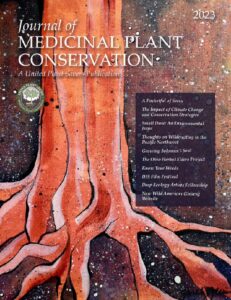[SIZE=4]Celebrating our Native Herbal Heritage: Sambucus canadensis[/SIZE]
by Rob and Hilary Templeton
Equinox Botanicals recently embarked on a mission to create a line of herbal syrups composed entirely of plants native or naturalized to North America. While developing the line’s ambassador, an Elderberry Syrup, following that criteria led to some encouraging discoveries that seemed to echo the project’s mantra: “Celebrate our native herbal heritage”.
Sambucus nigra, the European black elderberry, has centuries of recorded history. It is known as a plant that possesses the power to ward off evil spirits. It has been utilized as a food, a wine, a dye, and for a variety of medicinal applications, especially with symptoms presenting as the onset of a cold or flu. Modern studies are now validating folkloric medicinal use of the plant. S. nigra contains abundant quantities of anthocyanins, the anti-oxidant pigment that is responsible for giving the berries their purple-blue color. Our bodies use antioxidants to neutralize harmful free radicals and protect us from disease. According to the ORAC (Oxygen Radical Absorbency Capacity) method, elderberry’s “Total Antioxidant Capacity” is one of the highest of all small fruits, having nearly two times the value of cranberry and more than twice that of blueberry. A micronutrient powerhouse, the tiny fruit touts loads of vitamins and minerals including Vitamins A, B6, and C, calcium, iron, magnesium, and phosphorus. One of the most celebrated attributes of elderberry in recent research is its capacity to inhibit replication of 11 strains of influenza , while increasing cytokine production (immune-modulators). Elderberry certainly seems to have earned its reputation as a “super-food”, yet while S. nigra has been cultivated, bred, and marketed as a medicinal plant, its western cousin, Sambucus canadensis, or American Elderberry, remains relatively unknown to the public and the herbal medicine industry alike.
We know that S. canadensis was used extensively by Native Americans and early American settlers, but for some reason the plant has not been part of the recent herbal renaissance in which S. nigra has played such a major role. So, what does the research that we have on this humble denizen of the North American countryside tell us? The taxonomic closeness of these two related plants is such that they share many of the same properties, including vitamin, mineral, and anti-oxidant content. However, the total anti-oxidant potential in the American elderberry showed to be even higher than that of the European elderberry. For one thing, the European cropped species contains primarily four anthocyanins, while the North American variety contains seven. But the American elder anthocyanins displayed another important difference which helps explain the higher antioxidant potential. The anthocyanins in the American elder are acylated. This means that they show a resistance to both heat and light , protecting the antioxidants from break down during the processing stage. This makes S. canadensis a better candidate for use in end products as the acylated anthocyanins will have greater color stability and maintain a better antioxidant capacity. It seems that for folks living in North America who wish to reap the rewards of elderberry’s immune-boosting, micro-nutrient rich, flu-fighting powers, local is better in more ways than one!
To round out this all-native herbal syrup formula, we combine organic American elderberry fruit concentrate with a blend of tea borrowed from an old Appalachian cold formula composed of elder flower, yarrow, lemon balm, peppermint, slippery elm, and the anti-septic bee resin, propolis. This down-home formula with a twist is sure to be the bane of any cold’s existence. Equinox Botanicals Elderberry Syrup is on sale now to UPS members at: equinoxbotanicals.com. Use coupon code: UPSELDER to get a 10% discount off any syrup, including: Elderberry Syrup, Children’s Elderberry Syrup, and Rest & Relaxation Syrup.
Equinox has plans to create a full line of native herbal syrups with the next installments due in spring 2013. The entire line is dedicated to United Plant Savers with the hope of bringing renewed awareness to the challenges we face in ensuring the maintenance and growth of wild-medicinal plants and their habitats. Every bottle will carry a UPS membership offer form in its box, and 5% of all profits from sales will be donated to support United Plant Savers and their mission. The syrups will be offered to UPS members at a discounted rate for a period of time following each release. For more information about Equinox Botanicals Native Herbal Syrups or other products please visit www.equinoxbotanicals.com
Barak, V., T. Halperin, and I. Kalickman, “The Effect of Sambucol, a Black Elderberry-based, Natural Product, on the Production of Human Cytokines: I. Inflammatory Cytokines,” European Cytokine Network 2 (2001): 290-296.
Barak, V., S. Birkenfeld, T. Halperin, and I. Kalickman, “The Effect of Herbal Remedies on the Production of Human Inflammatory and Anti-inflammatory Cytokines,” Israel Medical Association Journal 4 (2002): 919-922.
Wu, X., L. Gu, R.L. Prior, and S. McKay, “Characterization of Anthocyanins and Proanthocyanins in Some Cultivars of Ribes, Aronia, and Sambucus and Their Antioxidant Capacity,” Journal of Agricultural and Food Chemistry 52 (2004): 7846-7856.
Wu, X., G.R. Beecher, J.M., Holden, D.B. Haytowitz, S.E. Gebhardt, and R.L. Prior, “Lipophilic and Hydrophilic Antioxidant Capacities of Common Foods in the United States,” Journal of Agricultural and Food Chemistry 52 (2004): 4026-4037
Thole, Julie M., Tristan F. Burns Kraft, Lily Ann Sueiro, Young-Hwa Kang, Joell J. Gills, Muriel Cuendet, John M. Pezzuto, David S. Seigler, and Mary Ann Lila, “A Comparative Evaluation of the Anticancer Properties of European and American Elderberry Fruits,” Journal of Medicinal Food 9(4)(2006): 498-504
Nakatani, N., H. Kikuzaki, J. Hikida, M. Ohba, O. Inami, and I Tamura, “Acylated Anthocyanins from Fruits of Sambucus canadensis,” Phytochemistry 38 (1995): 755-757.
Inami, O., I. Tamura, H. Kikuzaki, and N. Nakatani, “Stability of Anthocyanins of Sambucus Canadensis and Sambucus nigra,” Journal of Agricultural and Food Chemistry 44 (1996): 3090-3096.
Charlebois, D., “Elderberry as a Medicinal Plant,” in Issues in New Crops and New Uses, ed. J. Janick and A. Whipkey (Alexandria, Va: ASHS Press, 2007), 284-292.






